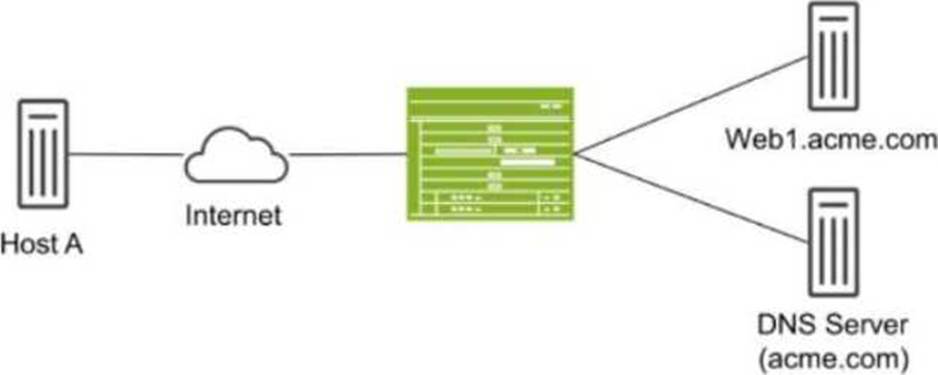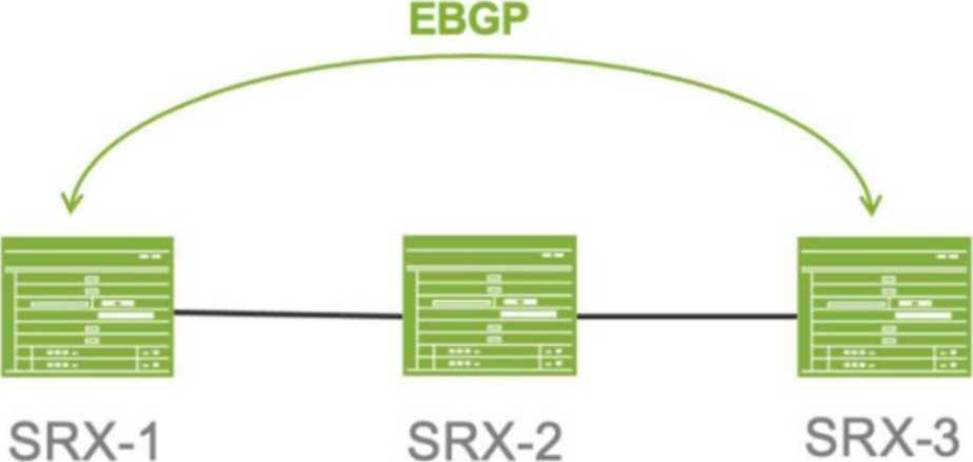Juniper JN0-637 Übungsprüfungen
Zuletzt aktualisiert am 20.12.2025- Prüfungscode: JN0-637
- Prüfungsname: Security, Professional (JNCIP-SEC)
- Zertifizierungsanbieter: Juniper
- Zuletzt aktualisiert am: 20.12.2025
You are enabling advanced policy-based routing. You have configured a static route that has a next hop from the inet.0 routing table. Unfortunately, this static route is not active in your routing instance.
In this scenario, which solution is needed to use this next hop?
- A . Use RIB groups.
- B . Use filter-based forwarding.
- C . Use transparent mode.
- D . Use policies.
Exhibit:

Host A shown in the exhibit is attempting to reach the Web1 webserver, but the connection is failing. Troubleshooting reveals that when Host A attempts to resolve the domain name of the server (web.acme.com), the request is resolved to the private address of the server rather than its public IP.
Which feature would you configure on the SRX Series device to solve this issue?
- A . Persistent NAT
- B . Double NAT
- C . DNS doctoring
- D . STUN protocol
Exhibit:

Referring to the exhibit, which technology would you use to provide communication between IPv4 host1 and ipv4 internal host
- A . DS-Lite
- B . NAT444
- C . NAT46
- D . full cone NAT
What are three core components for enabling advanced policy-based routing? (Choose three.)
- A . Filter-based forwarding
- B . Routing options
- C . Routing instance
- D . APBR profile
- E . Policies
You are asked to create multiple virtual routers using a single SRX Series device. You must ensure that each virtual router maintains a unique copy of the routing protocol daemon (RPD) process.
Which solution will accomplish this task?
- A . Secure wire
- B . Tenant system
- C . Transparent mode
- D . Logical system
A company has acquired a new branch office that has the same address space as one of its local networks, 192.168.100.0/24. The offices need to communicate with each other.
Which two NAT configurations will satisfy this requirement? (Choose two.)
- A . [edit security nat source]
user@OfficeA# show rule-set OfficeBtoA {
from zone OfficeB;
to zone OfficeA;
rule 1 {
match {
source-address 192.168.210.0/24;
destination-address 192.168.200.0/24;
}
then {
source-nat { interface; }
}
}
} - B . [edit security nat static]
user@OfficeA# show rule-set From-Office-B {
from interface ge-0/0/0.0;
rule 1 {
match {
destination-address 192.168.200.0/24;
}
then {
static-nat {
prefix { 192.168.100.0/24; }
}
}
}
} - C . [edit security nat static]
user@OfficeB# show rule-set From-Office-A {
from interface ge-0/0/0.0;
rule 1 {
match {
destination-address 192.168.210.0/24;
}
then {
static-nat {
prefix { 192.168.100.0/24; }
}
}
}
} - D . [edit security nat source]
user@OfficeB# show rule-set OfficeAtoB {
from zone OfficeA;
to zone OfficeB;
rule 1 {
match {
source-address 192.168.200.0/24;
destination-address 192.168.210.0/24;
}
then {
source-nat { interface; }
}
}
}
You are deploying a large-scale VPN spanning six sites.
You need to choose a VPN technology that satisfies the following requirements:
All sites must have secure reachability to all other sites.
New spoke sites can be added without explicit configuration on the hub site.
All spoke-to-spoke communication must traverse the hub site.
Which VPN technology will satisfy these requirements?
- A . ADVPN
- B . Group VPN
- C . Secure Connect VPN
- D . AutoVPN
Exhibit:

The Ipsec VPN does not establish when the peer initiates, but it does establish when the SRX series device initiates.
Referring to the exhibit, what will solve this problem?
- A . IKE needs to be added for the host-inbound traffic on the VPN zone.
- B . The screen configuration on the untrust zone needs to be modified.
- C . IKE needs to be added to the host-inbound traffic directly on the ge-0/0/0 interface.
- D . Application tracking on the untrust zone needs to be removed.
Click the Exhibit button.

Referring to the exhibit. SRX-1 and SRX-3 have to be connected using EBGP. The BGP configuration on SRX-1 and SRX-3 is verified and correct.
Which configuration on SRX-2 would establish an EBGP connection successfully between SRX-1 and SRX-3?
- A . The host-inbound-traffic statements do not allow EBGP traffic to traverse SRX-2.
- B . The security policy to allow SRX-1 and SRX-3 to communicate on TCP port 79 should be configured.
- C . The security policy to allow SRX-1 and SRX-3 to communicate on TCP port 169 should be configured.
- D . The security policy to allow SRX-1 and SRX-3 to communicate on TCP port 179 should be configured.
You configure two Ethernet interfaces on your SRX Series device as Layer 2 interfaces and add them to the same VLAN. The SRX is using the default L2-learning setting. You do not add the interfaces to a security zone.
Which two statements are true in this scenario? (Choose two.)
- A . You are unable to apply stateful security features to traffic that is switched between the two interfaces.
- B . You are able to apply stateful security features to traffic that enters and exits the VLAN.
- C . The interfaces will not forward traffic by default.
- D . You cannot add Layer 2 interfaces to a security zone.
